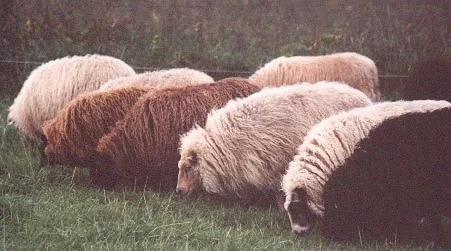Iceland! A fancy land full of progressive politics, beautiful landscapes, and home to one of my favorite fibers. Icelandic sheep and their wool are unlike any other in the world. As a result of having to endure such extreme climates and weather patterns over the past 1100+ years, Icelandic sheep have evolved to produce a unique type of fiber that is not only warm but also water-repellent and light-weight. I was fortunate enough to attend an educational walking tour led by The Icelandic Culture & Craft Workshop, which gave an in-depth look at the country’s wool industry; from fiber to manufacturer.
Our tour guide, Ragnheiður Jóhannsdóttir, explained to us exactly why this fiber is so outstanding and deserves to be cherished; starting with its varying layers. Icelandic wool includes an outer layer, which produces a long, glossy, waterproof thread; as well as an inner layer, which yields short, thin, yet extremely warm thread. Because Icelandic sheep have been isolated for centuries and have not experienced human breeding or any other types of climate, they exclusively produce strong, soft, durable wool. Our tour guide explained to us how well the fiber-producing sheep are treated; another explanation as to why their wool is so luscious. Every summer, the sheep are allowed to roam free on the grassy mountains of Iceland and eat as many plants as they please. This freedom and happiness they feel while exploring their natural environment make the sheep’s summer wool extremely high quality and more valuable than their denser wool produced in the winter. After learning all this information about such an amazingly unique fiber, I was surprised to hear how Iceland’s wool industry was once a dying one.
Iceland’s wool industry began about 120 years ago with the wool company, Álafoss. The Culture and Craft Workshop walking tour took us to Álafoss’s original factory and historical housing section, located in Mosfellsbær. Our tour guide led us to Álafoss’s main retail store; which happens to also be the original factory building and is home to vintage knitting machines and photographs from early production. While exploring the factory town, Ragnheiður shared how Álafoss was at its peak during the 1970s and 80s. After the Soviet Union, one of Iceland’s main trading partners collapsed in 1991, Álafoss went bankrupt and took the country's wool industry down with it. Fortunately, the few remaining wool manufacturers helped to revitalize the industry and maintain the traditional knitwear craft. Álafoss may never carry out production as it did nearly 50 years ago, however, its successful comeback exemplifies the country's irrepressible spirit and dedication to its resources.
So what does this all mean in terms of sustainability in the global fashion marketplace? Iceland's unforgiving climate has become a source of inspiration for its people and is treated with deserved respect. Its sheep and wool are as resilient as its people, who are devoted to maintaining the countries beauty. Iceland's wool industry and Álafoss's story of ups and downs can act as a model for fashion industries around the world. The modern fashion industry has absolutely no concern for the environment and treats clothing as disposable goods. Approximately 13.1 million tons of textile waste are trashed in the US alone each year. Icelandic wool sweaters are hand-knit investment pieces that deserve to be cherished. All garments deserve to be valued and loved as much as these traditional sweaters. The wool textile's natural composition means that it is able to decompose once it is no longer wearable. The increase in the popularity of synthetic fibers and blends means that the majority of those 13.1 million tons of textile waste will never break down. For the sake of our planet, our landfills, those in other countries who live in our textile waste, those whose work is not valued as it should be because our cheap t-shirts are worth more than them feeding their children; it is time to put value back into the clothing we wear. We must respect the land, animals, and people who work together to make our garments. We must be willing to spend more money on individual garments by treating them as investments rather than temporary goods. Just as Álafoss did not give up on Iceland's wool industry, the western world mustn't give up on the idea that clothes are valuable. They are, after all, our skin of choice.
~A.H.W.
Want to find out more about Iceland's wool industry? Check out these websites!
https://sourcebook.eu/en/blog/style-and-sustainability-introduction-icelands-fashion-industry






